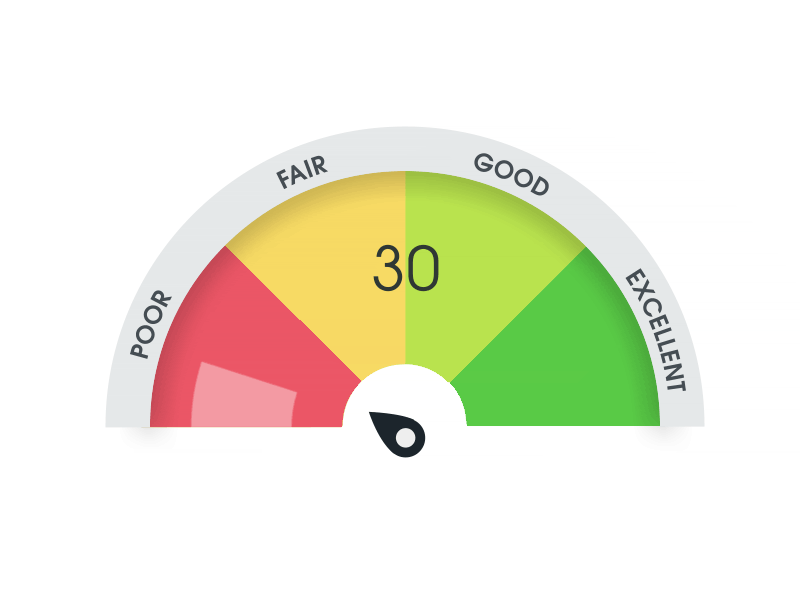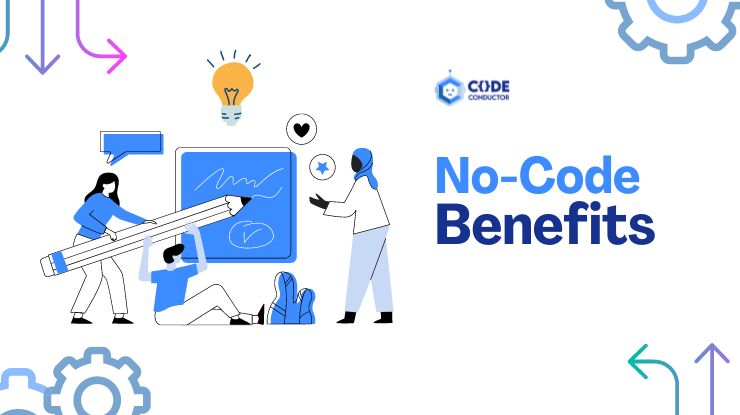According to Rradixweb – By 2025, 70% of newly developed applications will use low-code or no-code technology, up from less than 25% in 2020.
This shift is largely due to the rise in citizen developers – individuals without formal coding training who build apps using no-code platforms.
In fact, by the end of 2024, it’s expected that there will be four times as many citizen developers as professional developers. This trend is part of a larger movement toward IT democratization, allowing businesses of all sizes to create and automate their processes using no-code solutions, which are affordable, quick, and simple solutions.
In this article, we’ll explore the top 8 practical advantages of using no-code technology. Let’s take a look!
In This Post
What is No-Code Development?
No-code development refers to a method of creating websites and mobile applications without the need for writing a single line of code. Instead, it uses a graphical user interface with drag-and-drop elements and other intuitive tools to allow users to build web pages and applications. Now, without having programming knowledge or experience, you can create custom web pages and apps for your needs.
The core idea behind no-code development is to democratize the process of software creation, making it possible for non-technical individuals, often referred to as “citizen developers,” to contribute to app development.
This method can significantly speed up the development process and reduce costs, as it bypasses the need for specialized coding skills and resources. It’s particularly useful for building simple to moderately complex applications and for automating business processes.
No-code development platforms typically offer a range of pre-built templates and components, making it easier to design, test, and deploy applications. These platforms are increasingly popular in business environments for creating internal tools, e-commerce websites, business process automation, and even customer-facing applications.
What Can You Build With No-Code?
No-code technology is commonly used to create web pages and applications. With the top no-code platforms, you can build apps and websites similar to Slack, Starbucks, Zillow, DoorDash, growth tools, AI travel planning tools, Travel application etc. Here are some examples of how no-code can be utilized:
- Back-Office Applications: These are internal tools used by businesses for essential operations like managing invoices and keeping track of key performance indicators (KPIs).
- Websites: No-code platforms can build user-friendly web pages for various services, such as e-commerce store or restaurant reservation systems.
- Mobile Applications: These are mobile apps that allow employees to access and interact with back-office applications even when they’re away from the office, making remote work more efficient.
- Workflow Management: No code can be used to streamline internal processes. For example, setting up systems where employees can acknowledge the completion of tasks, and adhering to internal service-level agreements.
- Business Process Automation: This includes automating routine business functions, such as getting a document approved by multiple parties, which can save time and reduce errors.
- Human Resources Functions: No-code platforms can enhance HR management systems by adding self-service features, allowing employees to manage their personal information and requests independently.
Top 8 Benefits of No-Code Development
No-code development platforms offer a host of benefits that are hard to overlook. They are incredibly useful for everyone involved in app development – from business users and professional developers to citizen developers.
Such platforms allow for increased productivity through the reuse of codes and by providing ready-made components for app development. Essentially, they make it easier and more efficient to automate workflows and streamline processes.
Let’s delve into the benefits of no-code:
1. Anyone Can Build
If you’re someone who doesn’t know anything about coding, don’t worry! You can still create amazing things with a no-code development platform.
You don’t need to be a tech expert or have any coding skills. All you need is a great idea. With a no-code platform, you can easily build user-friendly and fully functional apps quickly – sometimes in as little as an hour.
A simple app can be built in just a few hours, while complex enterprise applications might take only a few weeks — a significant cut from the months-long timelines of traditional coding. These no-code tools are incredibly intuitive, featuring drag-and-drop interfaces that simplify the building process.
2. Low Development Cost
No-code platforms offer a cost-effective alternative to traditional app development. Instead of hiring an expensive IT team or skilled programmers, no-code platforms allow anyone with a basic understanding of business processes to create apps and website.

This approach significantly reduces development costs. Additionally, business owners who familiarize themselves with no-code platforms can directly transform their business ideas into apps, ensuring accuracy and alignment with business goals.
The savings in costs and resources make no-code development not just affordable, but also efficient for businesses of all sizes.
3. Rapid Development and Deployment
A standout benefit of no-code platforms is their remarkable speed in web pages and app development, making them essential in modern websites and mobile app development cycles. These platforms can accelerate website and app creation up to ten times faster than traditional methods.
Key features facilitating this rapid development include:
- Pre-built User Interfaces: Ready-to-use templates speed up the design process.
- Drag-and-Drop Functionalities: An intuitive way to build apps without coding.
- Reusable Codes: Minimizes repetitive work, enhancing efficiency.
- Workflow Automation Components: Streamlines business processes within the app.
- Easy API Integrations: Simplifies connectivity with other systems.
- Single-Click Deployment: Reduces the time from development to launch.
This approach not only speeds up the development process but also democratizes app creation, making it accessible and efficient. It’s a game-changer in the app development world, significantly reducing the time and effort required to go from idea to execution.
4. More Agile
No-code app development significantly boosts the agility of business teams, enabling them to adapt quickly to changing market trends and customer preferences. This approach allows for:
- Efficient Feature Tracking: Teams can easily monitor which app features are favored by users and swiftly identify those that are less impactful. This insight enables quick adjustments, ensuring the app remains relevant and user-centric.
- Rapid Prototyping and Feedback: No-code platforms excel in facilitating the creation and testing of complex app prototypes. This process allows for immediate user feedback, leading to quicker iterations and a more refined final product.
- Reliable Development with Built-In Tools: The inclusion of visual editors, automated testing, and error-checking tools in no-code platforms reduces the risk of bugs and errors. This reassurance allows developers to confidently make changes, enhancing the overall quality and reliability of the app.
Overall, no-code development empowers teams to be more responsive and efficient, making it a valuable tool in today’s dynamic business environment.
5. Better Integrations
No-code platforms simplify integrations remarkably. They come equipped with pre-built API connectors for easy linking to external systems like Salesforce and Google Drive, without needing any custom coding.
What’s more, their visual interfaces allow even non-technical users to easily set up and manage integrations through intuitive, drag-and-drop actions.
Additionally, these platforms offer customizable integration templates, speeding up and simplifying the process of connecting different systems. This user-friendly approach makes integrations not only quicker but also more accessible to everyone.
6. Quick Maintenance
Maintaining no-code apps is remarkably efficient, thanks to their user-friendly design. These apps feature visual interfaces that simplify understanding and modifying app components. Their modular design means issues in one area can be fixed without impacting the whole app.
Built-in tools for monitoring and error tracking further ease maintenance. Automatic updates keep the app current without manual intervention. Plus, their simplified code structure ensures that anyone can maintain the app over time, even if the original developer isn’t available.
This combination of features makes maintaining no-code apps a straightforward and hassle-free process.
7. Increased Productivity
No-code development makes creating applications much easier by doing repetitive tasks automatically and offering a variety of pre-built modules. This means that both people who know how to code and those who don’t can spend more time on important tasks, which makes them more productive.

For instance, a marketing team can use a no-code platform to set up a system that automatically gathers potential customers. This saves them time, allowing them to concentrate on developing relationships with these leads and making sales.
This minimizes the chances of technical glitches and allows business leaders to focus on solving real business problems rather than fixing bugs and technical errors. As a result, no-code development not only saves time and resources but also ensures a higher and more reliable return on investment.
8. Freedom To Focus On Business Development
Much like the revolution brought about by website builders, no-code platforms are simplifying the creation of applications that were previously complex to code. This advancement means that individuals and businesses can shift their focus from the technical aspects of app development to the business side of things.
With the technical hurdles significantly reduced, people can concentrate on refining their business strategies, understanding customer needs, and exploring new market opportunities. This shift allows for a more strategic use of time and resources, fostering innovation and business growth.
What is The Future of No-Code?
The future looks bright for no-code development, driven by high demand from business professionals and an increased need for IT support in remote work environments. This trend is highlighted by Gartner’s prediction that by 2024, 65% of app development will be no-code, with citizen developers far outnumbering professional ones by 2024.
Many platforms offer both no-code and low-code capabilities, and industry analysts like Gartner and Forrester often group these in market analyses. For example, Gartner’s $13.8 billion market projection for 2021 includes low-code, no-code, citizen development, and robotic process automation (RPA), among others.
Despite this overlap, the growing interest and rapid evolution in the field suggest a strong and expanding market for both no-code and low-code development solutions.
In these uncertain times, the no-code movement is gaining momentum, and it’s not just a passing trend. It’s a game-changer that’s here to stay. As businesses recognize the simplicity and effectiveness of no-code tools, we can expect more of them to be developed. This shift in app development is becoming the standard practice.
According to Gartner, Low-Code and No-Code Technologies Use Will Nearly Triple by 2025. 70% of new applications developed by organizations will use low-code or no-code technologies, up from less than 25% in 2020.
Explore our blog on ‘Low-Code vs No-Code Platform: Which is Best for You?‘ to navigate this evolving landscape and discover the right solution for your needs.
Hence, the future of app development is leaning heavily towards the no-code approach, and it’s an exciting transformation to be a part of!
Wrapping Up!
The benefits of no-code development, from its speed and cost-efficiency to its user-friendly nature, are revolutionizing app and website creation.
For those eager to dive into digital innovation without the complexity of coding, choose CodeConductor – AI powered software development platform to build software, app and website, a perfect solution. CodeConductor makes app development, e-commerce development, and other website development accessible to everyone, so you can concentrate on creativity and business growth.
Give CodeConductor a try today and experience the ease and efficiency of no-code development firsthand. Unleash your creativity and bring your digital projects to life effortlessly!

Founder CodeConductor
